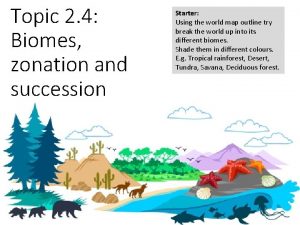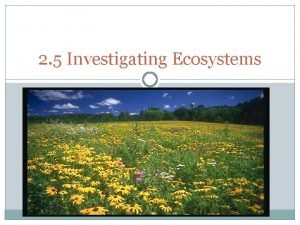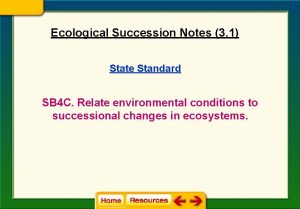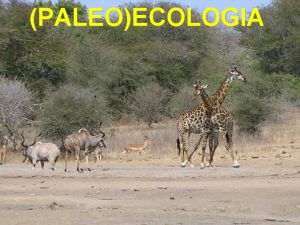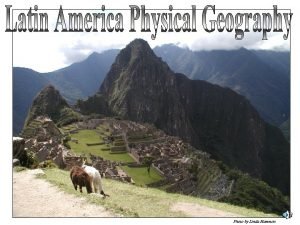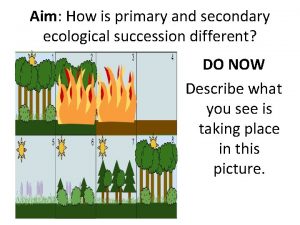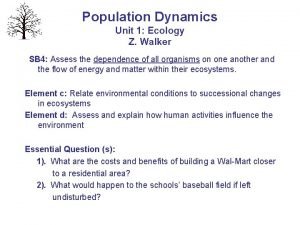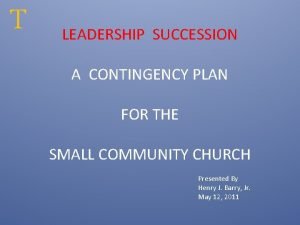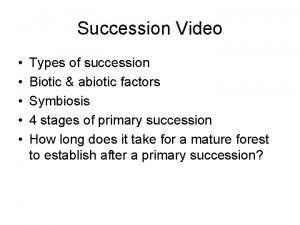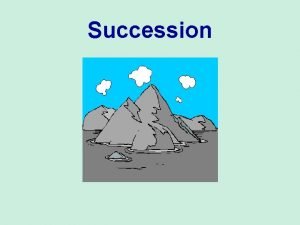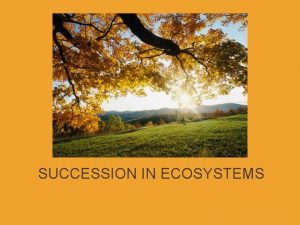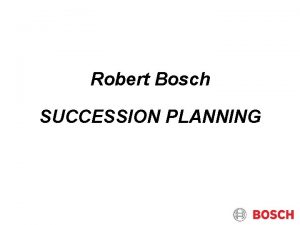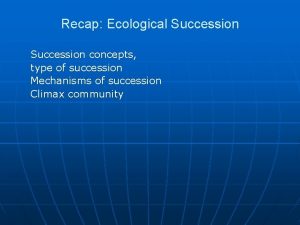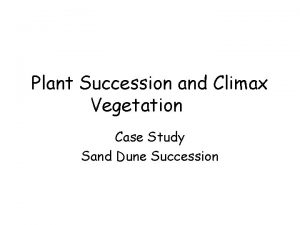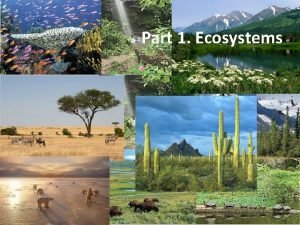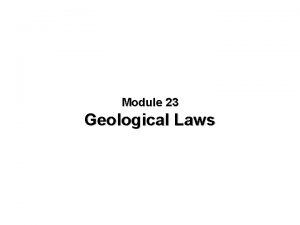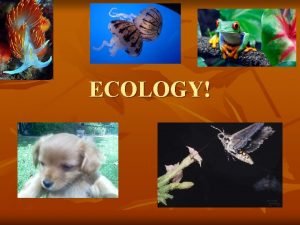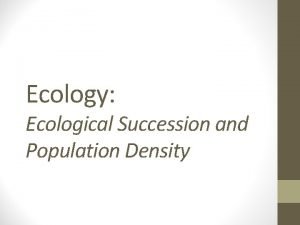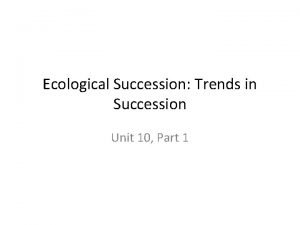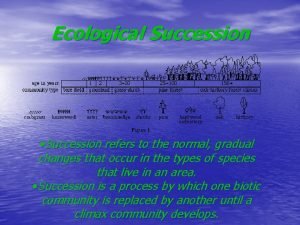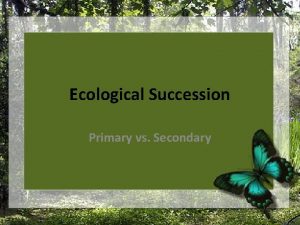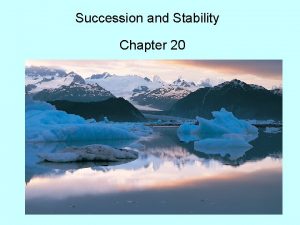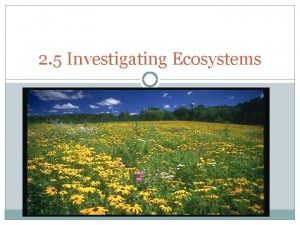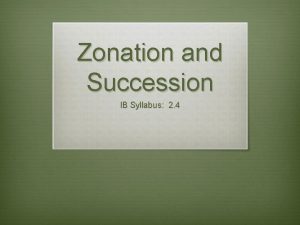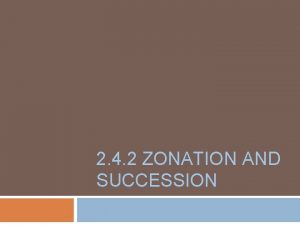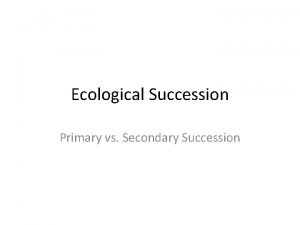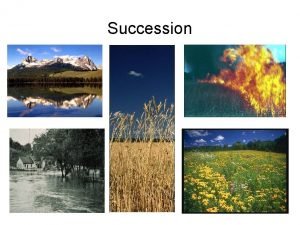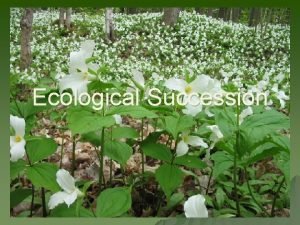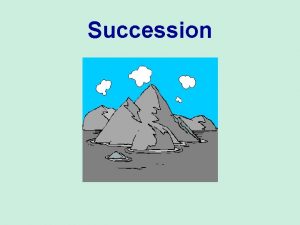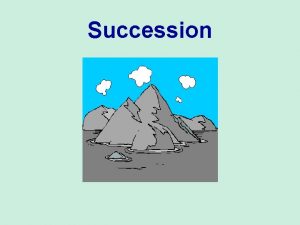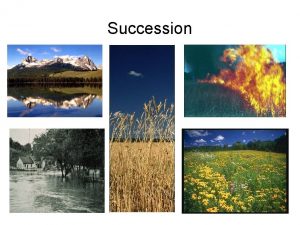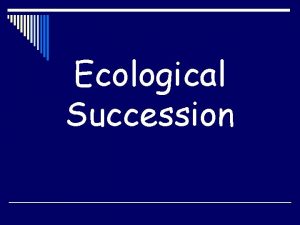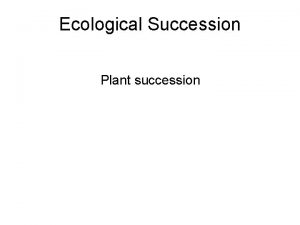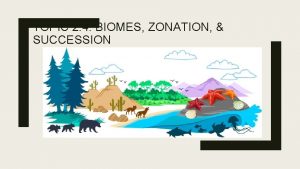2 4 2 ZONATION AND SUCCESSION What is












































- Slides: 44

2. 4. 2 ZONATION AND SUCCESSION

What is Succession – a predictable sequence of changes, caused by the living things themselves, where an ecosystem develops from a simple colonizer community to a complex climax community.

What is Succession – Orderly process of change over time in a community divided into stages called serals

Primary Succession Involves the introduction of species into an area that has never previously been colonized

Stages of Primary Succession Bare inorganic surface: Lifeless abiotic environment becomes available for colonization by pioneer plant, animal and lichen species. Soil is little more than mineral particles, nutrient poor and an erratic water supply. e Tim

Stages of Primary Succession e Tim 1. Stage 1 Colonization: First species to colonizer are pioneer species adapted to extreme conditions. Pioneer species are typically r-selected species showing small size, short life cycles, rapid growth and production of many offspring or seeds. Simple soil starts from windblown dust and mineral particles.

Pioneer Species


Stages of Primary Succession e Tim 1. Stage 2 Establishment: Species diversity increases. Invertebrates (no backbone) begin to visit and live in the soil, increasing humus (organic material) content and water-holding capacity. Weathering of rock enriches soil with nutrients.

Stages of Primary Succession e Tim 1. Stage 3 Competition: Microclimate continues to change as new species colonize. Larger plants increase cover and provide shelter, enabling Kselected species to become established. Temperature, sun and wind are less extreme. Earlier pioneer r-species are unable to compete with K species for space, nutrients or light and are lost from the community.

Stages of Primary Succession e Tim 1. Stage 4 Stabilization: Fewer new species colonize as late colonizers become established shading out early colonizers. Complex food webs develop. K-selected species are specialists with narrower niches. They are generally larger and less productive (slower growing) with longer life cycles and delayed reproduction.

Stages of Primary Succession e Tim 1. The final stage or climax community is stable and self-perpetuating. It exists in a steady-state dynamic equilibrium. The climax represents the maximum possible development that a community can reach under the prevailing environmental conditions of temperature, light and rainfall.

Primary Succession Occurs in new lakes, ponds, cooled lava, sand dunes and bare rock Ex - rock -> lichen -> moss -> grass -> shrub -> trees -> oak hickory forest

Secondary Succession Secondary succession – when an already established community is suddenly destroyed/disturbed

Secondary Succession Soils are already developed and ready to accept wind blown seeds. E. g. Forest fire, flood, grazing, deforestation, human activity (plowing), etc.

The Stages of Succession During succession, the following changes occur: The size of the organisms increases with trees, creating a more hospitable environment. Energy flow becomes more complex as simple food chains become complex food webs.

The Stages of Succession Soil depth, humus, water-holding capacity, mineral content, and cycling all increase. Biodiversity increases because more niches (lifestyle opportunities) appear and then falls as the climax community is reached. NPP and GPP rise and then fall. Productivity: Respiration falls.

Climax communities Not necessarily dense forest. There is no one climax community. Many stable alternatives Dependant on: Climatic factors Soil properties Random events **Complex ecosystems are more stable due to the variety of nutrient and energy pathways. If one collapses its overall effect is low as there are many others to takes its place.

Secondary Succession that occurs where an area has been disturbed. Ex - grass -> shrub > trees -> oak hickory forest

Secondary Succession Annual weeds Perennial weeds and grasses Shrubs and small pine seedlings Time Young pine forest with developing understory of oak and hickory trees Mature oak and hickory forest

GPP and NP During Succession (a summary) EARLY STAGE MIDDLE STAGE Low GPP but high % of NPP. Little Increase in Biomass. Grasses, herbs, small shrubs grow. GPP is high. Increased photosynthesis. Increases in biomass as plants become larger. As woodland species and biomass increases, so does productivity, but NPP as a % of GPP falls as respiration rates increase. LATE STAGE Trees reach their maximum size. Ratio of NPP to R is roughly equal. Both biodiversity and mineral cycling increase strongly as succession progresses.

Biodiversity in Successions In early stages of succession, there are only a few species within the community. As the community passes through subsequent stages, species diversity increases (to a point).

Secondary Succession Human activities usually cause secondary succession. Cutting for timber Clearing for farming Construction Some Natural Causes Forest fires Volcanoes Hurricanes Tornados

Stages of Succession Pioneer community – Earliest seral stage Early Stages of Succession: Gross Productivity: low Respiration loss: low Net Productivity: high System: Growing

Stages of Succession Climax community – Final seral stage Final Stages of Succession: Gross Productivity: high Respiration loss: high Net Productivity: near 0 Production/Respiration Ratio: Near 1

Climax Community A climax community produced by the action of humans is called a PLAGIOCLIMAX. This may occur for the following reasons:

Climax Community The introduction on non-native species The effects of acid rain The effects of global warming Deforestation The planting of crops

Climax Community The grazing of cattle Agricultural operations Forestry Deliberate maintenance of grasslands, heathlands and coppice woodlands Land clearance Fire

Zonation

What is Zonation –Zonation is the change in community along an environmental gradient due to factors such as changes in altitude, latitude, tidal level or distance from shore/coverage by water.

What is Zonation Human activities alter zonation. Road building on mountains may allow tourism into previously inaccessible areas or deforestation or agriculture.

Zonation • • • Each species has an ecological niche (boundaries). The niches change as we increase the altitude. Temperature – decreases with increasing altitude and latitude. Precipitation—Higher up on mountains, the air is too dry and cold for trees. Most rainfall is in the middle altitudes where deciduous trees grow.

Zonation • • • Solar insolation—more intense at higher altitudes and plants have adapted to this. Soil type—in warmer zones, decomposition is faster so soils are deeper and more fertile. Higher up, decomposition is slow with acidic soils. Species interactions—competition may crowd out some species and grazing may alter plant composition. Mycorrhizal fungi may plan an important role in tree growth.

Succession vs Zonation (a comparison) Succession is how an ecosystem changes in time. Zonation Succession Spatial and Static Dynamic and temporal (takes place over long periods of time) Caused by an abiotic gradient. Mountains—changes in temperature. Seashore— changes in time exposure to water/air. Caused by progressive changes through time, eg. , as vegetation colonizes bare rock. Ex. Rocky Seashore, mountain slopes Terrestrial

Reproductive Strategies

The Role of r and K strategists in Succession Species can be roughly divided into K- and rselected species. K and r are two variables that determine the shape of a population growth curve.

The Role of r and K strategists in Succession K = carrying capacity r = describes the exponential part of a growth curve. K- and r- strategies describe the different approaches species take to getting their genes passed onto the next generation and ensuring the survival of the species.

The Role of r and K strategists in Succession S-shape curve represents a population that is at carrying capacity (Kstrategy species) J-shape curve represents a population existing in an exponential phase of growth (rstrategy species)

r-strategist Short life Rapid growth Early maturity Numerous and small offspring Little parental care or protection Little investment in individual offspring Adapted to unstable environment. Pioneers, colonizers Niche generalists Prey Regulated mainly by external factors Lower trophic level

K-strategist Long life Slower growth Late maturity Fewer, but large offspring High parental care and protection High investment in individual offspring Adapted to stable environment Later stages of succession Niche specialist Predators Regulated mainly by internal factors Higher trophic level

Survivorship Curve Limiting factors that affect the shape of the curve include predation, competition, environmental conditions. Curve II is rare in that species have an equal chance of dying at any age (ex. Hydra and some bird species).

Activity: Using sand dunes as an case study (pg. 121) outline the stages of succession. Oldest • For each of the 5 stages outline how the following change: • Size and diversity of organisms • Complexity of energy flows • Soil • NPP and GPP (explain why they change) • Productivity : respiration ratio Younge st

Summary of Key Points Succession is the change in species composition in an ecosystem over time. It may occur on bare ground (primary succession) when soil formation starts the process or where soil already formed but the vegetation has been removed (secondary succession). Early in succession, gross primary productivity (GPP) and respiration are low and so net primary productivity (NPP) is high as biomass accumulates.

Summary of Key Points In later stages, while GPP may remain high, respiration increases so NPP may approach zero and the productivity : respiration ratio (P: R) approaches one. A climax community is reached at the end of succession when species composition stops changing. But there may be several states of a climax community, depending on abiotic factors. The more complex the ecosystem (higher biodiversity, increasing age), the more stable it
 Tri cellular model of atmospheric circulation upsc
Tri cellular model of atmospheric circulation upsc Zonation and succession
Zonation and succession Zonation and succession
Zonation and succession Succession vs zonation
Succession vs zonation Ecological succession succession of a pond
Ecological succession succession of a pond Ecological succession succession of a pond
Ecological succession succession of a pond Zonation in aquatic biomes
Zonation in aquatic biomes Sepkoski
Sepkoski Linda hammon
Linda hammon Talent management and succession planning toolkit
Talent management and succession planning toolkit Primary and secondary succession weblab
Primary and secondary succession weblab Ecological succession
Ecological succession Succession venn diagram
Succession venn diagram What are the steps of secondary succession
What are the steps of secondary succession What does the word succession mean
What does the word succession mean War of austrian succession definition
War of austrian succession definition Line of succession to president
Line of succession to president Presidency line of succession
Presidency line of succession Ibm succession planning
Ibm succession planning Cipd succession planning
Cipd succession planning Church leadership succession planning
Church leadership succession planning Biotic succession
Biotic succession Deflected succession definition
Deflected succession definition Fire department succession planning
Fire department succession planning Succession def
Succession def Halosere succession
Halosere succession Mid succession
Mid succession Laterial continuity
Laterial continuity Diversified succession plan
Diversified succession plan Ecological succession concept map
Ecological succession concept map Presidential succession
Presidential succession Presidential succession
Presidential succession Ecological succession case study
Ecological succession case study Ecological succession
Ecological succession Istvan van tuyl
Istvan van tuyl Les connecteurs textuels
Les connecteurs textuels War of spanish succession definition
War of spanish succession definition Principle of faunal succession
Principle of faunal succession Types of succession planning
Types of succession planning Flow of energy vs flow of matter
Flow of energy vs flow of matter Ecological succession comic strip
Ecological succession comic strip Ecological disturbance
Ecological disturbance Ecological succession
Ecological succession When does a climax community change
When does a climax community change Primary v secondary succession
Primary v secondary succession
